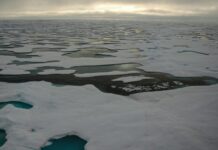Triple Divide Peak, a remote mountain within Montana’s Glacier National Park, holds a unique geographical distinction: a single drop of water resting on its slopes could eventually flow into one of three oceans – the Pacific, Atlantic, or Arctic. This remarkable convergence makes it the only place on Earth, arguably, where waters have the potential to contribute to three separate oceans, rather than just seas or a combination of seas and oceans.
The Concept of a “Triple Divide”
What defines this special place is its status as a “triple divide,” also known as a “hydrological apex.” These points occur where multiple watersheds meet. Essentially, they are locations from which water flows into different drainage basins, each leading to a distinct body of water. While other triple divides exist globally, Triple Divide Peak stands out for its potential to send water into three separate oceans. However, whether it definitively holds this title is a point of ongoing debate among scientists.
How Water Chooses Its Path
The magic of Triple Divide Peak stems from its position on North America’s Continental Divide. Imagine an imaginary line stretching through the Rocky Mountains — this is the Continental Divide, separating river systems that ultimately flow towards the Pacific, Atlantic, and Arctic oceans. When snow melts or rain falls on the peak, the resulting water can take different paths:
- Pacific Route: Water can flow west through the Columbia River drainage basin, eventually reaching the Pacific Ocean.
- Atlantic Route: Alternatively, it can travel east along the Missouri and Mississippi rivers and into the Atlantic Ocean.
- Arctic Route: Meltwater or raindrops can also flow into Hudson Bay via the Saskatchewan River.
The International Hydrographic Organization considers Hudson Bay part of the Arctic Ocean. Therefore, by this classification, Triple Divide Peak contributes to three distinct oceans.
The Debate Over Hudson Bay’s Status
The ongoing scientific discussion revolves around whether Hudson Bay should be considered part of the Arctic Ocean or a sub-basin of the Atlantic Ocean. Some scientists contend that Hudson Bay is a part of the Atlantic, which would mean Snow Dome in Canada becomes the sole triple divide connecting three oceans. In this view, water from Triple Divide Peak only contributes to the Pacific or Atlantic.
Other “Great Divides”
Beyond the Continental Divide, Triple Divide Peak and Snow Dome are significant due to their position on other “great divides,” which delineate different watersheds.
- Triple Divide Peak: Sits on the Laurentian Divide, separating the Hudson Bay watershed (to the north) from the Gulf of Mexico watershed (to the south).
- Snow Dome: Lies on the Arctic Divide, distinguishing the Arctic Ocean watershed (northwest) from the Hudson Bay watershed (southeast).
This complex arrangement highlights how these peaks are not just geographical landmarks but crucial nodes in North America’s intricate water network.
Triple Divide Peak represents a rare confluence of geographical and hydrological forces, emphasizing the interconnectedness of North America’s water systems.
The existence of Triple Divide Peak underscores the fascinating and often surprising ways geography shapes the flow of water across our planet. It serves as a powerful reminder of the unique features of our natural world and the intricate relationships that govern our planet’s resources.












































